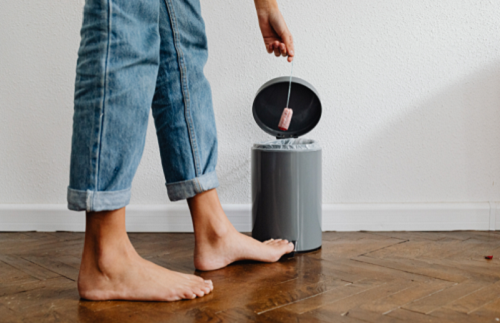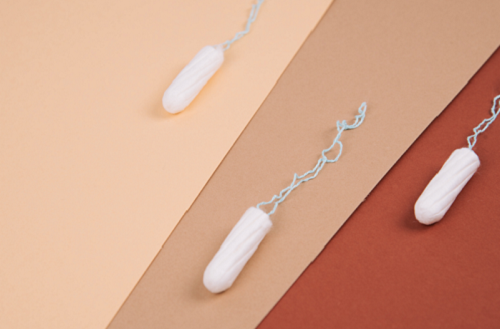Disposing a used tampon should be as simple as wrapping it in tissue paper and throwing it in the garbage or trash bin. Yet some people still flush it down the toilet, whether by accident or knowingly. Most tampons are biodegradable but take a long time to degrade. While they can be flushed down the toilet, they can still cause clogging and, in turn, costly repairs. So, what will dissolve tampons in pipes?
Certain chemicals like Drano and sulfuric acids can break down the components of a tampon, thus helping to unclog toilets blocked by tampons. Stay on to find out how to unclog toilets blocked by tampons and how to dispose of a tampon, among other things.
What Are Tampons Made Of?
To know what will dissolve tampons in pipes fast, you first need to know the different types of tampon materials. That’s because the right chemical you’ll need to dissolve tampon clogs will depend on the type of tampon you flush.
The standard tampons are made of cotton, rayon, or a blend. Tampon companies use rayon because it’s more absorbent than 100% cotton, making their tampons more leak-proof. But this characteristic also increases the risk of Toxic Shock Syndrome.
Conversely, cotton is a natural and safe material for such hygiene products. Cotton tampons are also known to be skin-friendly, highly absorbent, and comfortable. They are biodegradable, meaning they can dissolve easily in chemicals, thus helping to unclog toilets blocked by such tampons.
Dioxins and Bisphenol-A (BPA) are other commonly used substances in the manufacture of tampons, although the amount of these synthetic compounds is low.
Does Anything Dissolve Tampons?
As mentioned earlier, tampons are made of different materials. Those with synthetic material are mostly non-biodegradable. As a result, it’s impossible to find a solution that can break down synthetic components and dissolve the tampons.
On the other hand, if the tampons are organic, the following chemicals can dissolve them and help clear out blockages:
Drano
Drano is a popular drain cleaner containing sodium hydroxide, sodium hypochlorite, aluminum, sodium nitrate, and sodium chloride. These ingredients are known to dissolve various things, including gunk, hair, soap scum, and even tampons.
When you pour drano down the drain, the chemicals combine to produce heat at almost boiling temperatures, which speeds up decomposition. Remember that it can only dissolve cotton-based tampons and not synthetic ones.
Be sure to avoid using Drano regularly or leaving it to sit for too long because that can damage the drains and the septic tank. It would help if you also flushed with hot water afterward to clean the pipes.
Will Sulfuric Acid Dissolve Tampons?
Like Drano, a sulfuric acid drain-cleaner creates a chemical reaction with the blockage. It can quickly dissolve cotton-based tampons in pipes, making it easier to flush down.
Other chemicals that can dissolve natural tampons include:
- Nitric acid
- Hydrochloric acid
- A urea/sodium hydroxide aqueous solution
- Schweizer’s Reagent
How to Get Tampons Out of Pipes
What if you fail at dissolving tampons in pipes with chemicals? Or you want to remove blockages caused by synthetic-based tampons. It’s time to look at how to unclog tampons from pipes:
The most effective (albeit gross) way to remove a tampon from pipes is to pull it out manually. There are two potential ways to achieve this:
Remove the Toilet Altogether and Reach for the Tampon from the Drain Pipe
If you’ve just dropped a tampon in the toilet, it could still be in the drainpipe just after the toilet trap/trapway. In that case, you can reach into the toilet and grab the tampon. Of course, there are key steps to doing this.
- First, wear a pair of long rubber gloves covering up to your elbow. Ensure they fit snugly as well.
- Secondly, remove as much water from the toilet as possible using a cup. You can even place a sponge inside the toilet to absorb any remaining liquid.
- Using an adjustable wrench, remove the bolts holding the toilet bowl. This will provide enough space to work.
- Next, confirm that the gloves are on tight, and then place your hand into the open drain pipe. Try to locate the tampon(s); when you do, dispose of them immediately in a garbage bag.
- Reattach the toilet bowl and flush it to confirm it’s unclogged.
Unclog Your Toilet with Tools
Most people can’t stomach the thought of putting their hand into the toilet drain. Luckily, there’s a plumbing snake to help unclog drains.
Note that you should never plunge the toilet as that will only push the tampon further down, where it may be more difficult to remove and cause more damage.
The procedure for removing a tampon with a plumbing snake is quite similar to the one above, except instead of using your hand to reach into the drain pipe, you can use this tool.
- Carefully insert the plumber’s snake and push it down until you feel some resistance. This will indicate that you’ve reached what is causing the blockage, in this case, the tampon.
- Rotate the tool for the hooks to get a hold of the stuck tampon. This may take time, so be patient.
- You can then pull it out to see if it captured the tampon. If it didn’t, try again. And if it did, dispose of the tampon in a garbage bin.
- Lastly, reattach the toilet bowl and flush it to see if the toilet has been unclogged.
While it can be effective, using a drain snake to unclog tampons from pipes is not recommended. All the poking and turning might break up the tampon, and the generated fragments could also block the waste pipe. Hopefully, any remaining parts can be flushed down.
If you cannot unclog your toilet after attempting the above solutions, it’s time to call a plumber.
Why Do Tampons Cause Clogs?

Given the tampon’s small size, you’re probably wondering how they can cause a clog. These products are made to be absorbent and often expand in the vajajay to prevent leakage.
With these characteristics in mind, a tampon into your toilet will absorb the water and increase in size tremendously. The more water they absorb, the bigger they get.
Did you know that a tampon can increase almost 10x its original size? Now imagine two or more tampons down your drains; they’re bound to cause blockage.
Secondly, they don’t break down quickly like toilet paper, not to mention the synthetic types that don’t break down at all.
FAQs
There’s so much more about what will dissolve tampons in pipes that we can’t fit into a single article. But before we conclude, let’s skim through some common questions people ask regarding this topic:
How Long Does It Take for a Tampon to Clog a Toilet?
Immediately you flush a tampon down the toilet, it will start absorbing water and expanding. And soon enough, it will begin causing plumbing problems.
So, how do you know if your tampon is clogged in the toilet? Don’t panic if you accidentally flush a tampon into the toilet. There’s a chance it could pass down to the sewer system. If not, here are signs a tampon has caused a clog:
- Gurgling sounds in the drains or pipes
- Water backing up out of the plumbing system
- An overflowing toilet
- Water pooling around drains or toilets
- Raw sewage odor
How Long Does It Take a Tampon to Dissolve in Water?
Tampons are designed to stay up to 8 hours and come out of the vagina whole. They wouldn’t be effective if they broke down so easily in liquid now, would they?
Tampons hardly disintegrate, and while some are biodegradable, it can take many months. Obviously, you don’t have all this time to wait for the tampon to clear from your toilet drains while causing a blockage.
Will Drain Cleaner Dissolve Tampons?
As we saw earlier, drain cleaners like Drano work well to dissolve cotton-based tampons stuck in the toilet drains.
Can One Tampon Clog a Toilet?
Tampons are small enough to go down the toilet without causing any blockage. However, they are super absorbent and expand when in contact with any liquid, making them big enough to cause a clog.
If you continue flushing tampons, they will accumulate and cause an even more significant blockage. No specific number of tampons is required to cause a blockage to the toilet drain or septic tank. But it’s best to avoid flushing even a single tampon down the toilet.
I Flushed a Tampon Down the Toilet; What Should I Do?
Nothing much, other than watch out for signs of blockage. And if there’s one, take the steps outlined earlier to remove or dissolve a clogged tampon in pipes.
Final Thoughts on What Will Dissolve Tampons in Pipes
Tampons don’t belong in toilet drains or the septic tank. But don’t freak out if you accidentally flush one into your toilet. This is especially true for cotton tampons as they can be dissolved using certain chemicals, thus fixing the blockage issue.
Note that the best way to dispose of a tampon is to wrap it in tissue paper and throw it in the garbage bag. This applies to when you’re using a public toilet as well.


